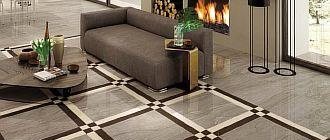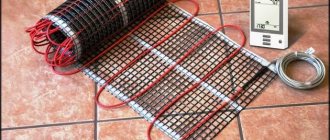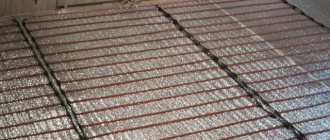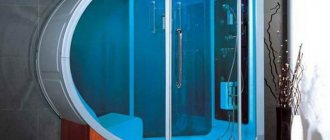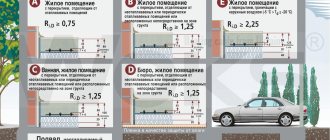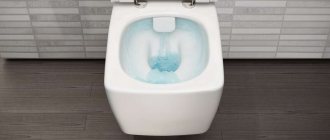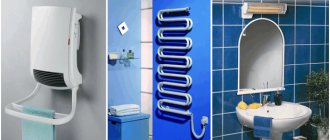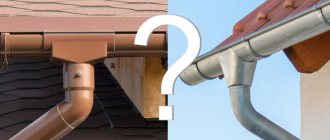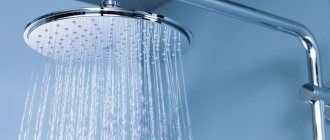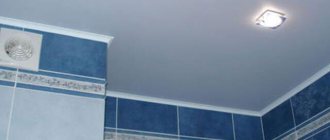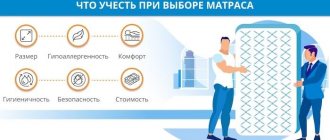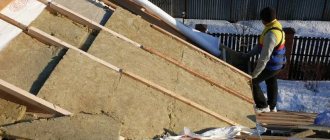An easy-to-install gypsum or cement-polymer self-leveling floor will allow you to independently level the surface of the concrete screed with optimal expenditure of working time and money. The technology is based on the use of environmentally impeccable self-leveling dry construction mixtures, characterized by ease of preparation, strength, hardening time and service life. But which self-leveling floor is better for a country house: gypsum or cement?
Gypsum and cement self-leveling floors
These mixtures received their names - gypsum and cement self-leveling floors - from the type of binder used in the mixture. As you already understood, in one case it is gypsum, in another case it is cement.
Because of this, these building mixtures have different characteristics and, most importantly, different areas of application.
gypsum and cement self-leveling floors
Floor coating with liquid glass
Among other things, liquid glass is often used to fill the floor. After installation, such a self-leveling floor creates a smooth and glossy surface that is very reminiscent of real glass, only in liquid form. It is often found in medical institutions because it is easy to clean and does not absorb bacteria. In fact, liquid glass is always glossy and transparent, but it is possible to paint it in order to achieve a different shade. In these cases, special dyes are used that are added to the mixture.
You can also create a 3D effect. To do this, you need to put a printed drawing or other three-dimensional objects of your choice and color between the layers.
The advantages of such floors:
- Smooth surface.
- Does not burn.
- Does not react to chemicals.
- Vibration resistant.
Gypsum self-leveling floors
Gypsum self-leveling floor is a dry construction mixture based on high-strength gypsum binder. In addition to gypsum, the mixture includes: quartz sand and special additives that improve the plasticity of the resulting solution.
Distinctive features of gypsum self-leveling floors are a relatively high hardening speed and a low threshold for the minimum pouring thickness of 1-2 mm.
A large assortment of gypsum floors from a large number of manufacturers makes it difficult to derive the average characteristics of this type of floor. However, to demonstrate their advantages and disadvantages, I will show the popular brand of gypsum self-leveling floor Knauf Boden 30. And I will start with the fundamental disadvantages of gypsum-based self-leveling floors.
Selection of finishing compositions
Of the huge range of flooring compositions, it is worth noting the most popular:
“Prospectors Quick-hardening” (from 270 rubles) based on gypsum. Most often used in living quarters, kitchens and hallways. A mobile solution, within forty minutes you can have time to pour it over a fairly large surface. A fairly well-known mixture that is used even by experienced specialists.
“Prospectors Tolstoy” (from 230 rubles) based on cement. Levels concrete floors with very strong unevenness. Used for applying thick layers. They come out heavy, but at the same time durable. Suitable for garage and bathroom, as well as outdoors with some kind of canopy. It takes the longest to dry on this list.
Brand Unis. “Horizon Universal” (from 270 rubles). Suitable even for wet rooms, on any basis. The name speaks for itself - the mixture is universal, it can be used under tiles in a toilet or bathroom.
Bergauf Easy Boden (from 340 rubles). It can be poured both in living quarters and in the bathroom and toilet. Also suitable for creating “warm floors” and for any fine finishing.
“Knauf-Tribon” (from 320 rubles). Suitable for all types of premises, including toilet floods. You can walk on the surface after 6 hours, and a day later you can put up furniture and continue repairs.
You need to be careful when choosing mixtures for self-leveling floors. Consider all factors: type of room, temperature, humidity, further finishing option, and so on. Do not forget to read the composition of the mixture, it can indicate the quality of the product, and during the process of pouring the floor, carefully follow the technology. Only in this case will you be able to make a self-leveling floor at home.
To learn how to choose a cement-based self-leveling floor, see the following video.
Disadvantages of gypsum self-leveling floor
The presence of gypsum binder in the mixture imposes restrictions on the use of this mixture. Gypsum self-leveling flooring cannot be used in damp rooms, much less outdoors. Only indoor spaces with normal and dry humidity are suitable for its use.
As a result, you cannot use gypsum self-leveling flooring in the apartment in the bathroom, toilet and kitchen. If the kitchen in the apartment can still be considered for the use of gypsum floors, then the bathroom and unheated balcony are not exactly suitable.
There are no other restrictions for the use of gypsum self-leveling floors. They can be used:
- For installation of connected self-leveling floors with a thickness of 25 mm or more. The bonded floor is poured directly onto the supporting base after priming.
- Floor installations on a separating layer with a thickness of 30 mm or more.
- When installing floating insulated floors with a thickness of 35 mm or more.
- Underfloor heating covers, 35 mm thick.
As you can see, even with restrictions on humidity, the range of applications for gypsum self-leveling floors is enormous.
I would add to the advantages of gypsum floors:
- Possibility of application by machine;
- No restrictions on finishing coatings;
- Possibility of walking in 3-4 hours;
- Complete drying for laying tiles takes 3 days. For other coatings 5-7 days.
Of course, we do not forget about the properties of self-flowing and self-leveling, after knocking out the air from the spilled solution with an aeration roller.
Screed and its types
A screed is a thin-layer coating in buildings that serves to absorb, redistribute loads and transfer them to the base of the floor.
The screed happens:
- by state of aggregation: dry, semi-dry and wet;
- by installation method: conventional, floating and prefabricated;
- according to additional properties: heat insulating, sound insulating, waterproofing and others.
Leveling wet screeds are considered the most popular. According to SNiP building codes, such a screed can be applied in a wide range of thicknesses from 1.5 to 30 cm. This allows you to qualitatively equip almost any floor or level any surface. After curing, the mixture is securely fixed to the rough base. With proper installation, a floor with ideal flatness is formed.
How to work with gypsum self-leveling flooring
50 kg of dry mixture yields 26 liters of solution. Mixture consumption per 1 sq. meter of floor is 19 kg per 10 mm of fill.
For work you will need:
- Tools for measuring floor and mortar levels;
- Construction bucket 30 liters;
- Mixer at low speed (can be replaced with a drill with a mixer attachment);
- Squeegee for dispersing the solution on the floor;
- Aeration roller for knocking air out of the solution;
- Shoe attachments for walking on mortar.
Preparing the base
The supporting base must be cleared of debris and dust.
For a bonded screed, the base needs to be primed twice. A deep penetration primer is used for concrete slabs, a strengthening primer for weak and old foundations, and a “concrete contact” primer for monolithic concrete or ceramic floors.
If the screed is made on a separating layer, for example cellophane, on a solid wooden base. The separating layer is laid with an overlap of at least 80-100 mm, overlapping the walls of the room. An edge strip is attached around the perimeter of the room.
Under a floating screed, for example on expanded polystyrene boards, a separating layer of cellophane or lining paper is laid overlapping. Extruded polystyrene foam does not react with mixtures and does not require covering with cellophane.
If mineral wool slabs are used as insulation, then GVL slabs are laid on top of the wool. As an option, KNAUF sheets of the dry floor system.
Warm floors are installed using our own technologies.
Preparation of the solution
The gypsum self-leveling floor solution is prepared according to the instructions on the specific packaging, but the general principles are the same.
- Pure cold water (4-4.5 liters) is poured into a dry, clean bucket. Water from standing sources, reservoirs, industrial water is not suitable;
- Dry mixture (20 kg) is poured into water;
- Using a mixer at low speed, mix the mixture until a homogeneous mass is obtained. High mixing speeds add a lot of air to the solution, so they are not advisable.
Checking the consistency of the self-leveling floor solution
The consistency of the solution is checked using the graduated cylinder method. Take a piece of plywood or chipboard and wrap it in cellophane, without creases. Make a cylinder 180 mm high and 100 mm in diameter (a sewer pipe will do). Place the cylinder on the plywood, press firmly and fill completely with the prepared mixture.
With the correct consistency of the self-leveling floor solution, the mixture should spread into a “puddle” of 40-42 cm in 120 seconds.
Pouring the solution
The solution is poured continuously, from the far corner of the room. The pouring area must be chosen so as to have time to process the solution within 10 minutes.
By processing the mixture we mean spreading the mixture along the base to the required level with squeegees. Also, knocking out the air mixture with a roller or stiff brush. The brush is used when covering a warm floor with a solution so as not to damage it.
Types of polymer coatings
Polymer-based self-leveling floors, depending on the composition, can be of the following types:
- Methyl methacrylate. This composition has a number of universal properties. The mixture hardens quite quickly, and pouring can be done even in rooms with low temperatures. The surface is very durable and reliable, so polymer self-leveling floors can be subjected to serious dynamic loads;
- The epoxy composition of polymer floors allows them to be used in rooms with high levels of humidity. They are also resistant to chemical and mechanical influences. Therefore, they can often be found in laboratories and pharmaceutical plants;
- Polyurethane mixtures. The properties of polymer floors of this type are very diverse. Unlike other materials, polyurethane has good elasticity and strength, so the coating is not subject to impact deformation. Most often it is used in residential areas, where surfaces are often subject to mechanical influence;
- Polyester materials are low cost, which is reflected in the characteristics of the floor itself. This type of coating cannot be called durable due to the low level of resistance to mechanical damage;
- Cement-acrylic mixtures. Polymer poured floors of this type are produced on the basis of dry building compounds. The surface is quite durable, and the coating is not afraid of significant temperature changes.
Self-leveling polymer coating flooring has not only good technical parameters, but also excellent aesthetic characteristics. Due to this, they are used in private homes, offices, shopping pavilions, and shops.
Types of floors and areas of application
Each individual industrial sector has its own specific conditions, according to which one or another type of flooring is suitable. The main varieties include:
- Decorative. They have excellent aesthetic properties and a wide range of colors. They are used in exhibition halls, trade pavilions, and offices. They are resistant to UV radiation, so the matte or glossy surface does not fade over time;
- Anti-slip. Used in food processing where the surface is often exposed to liquids. Thanks to the tightness of the floors, leakage is avoided. In residential premises they are installed in kitchens and bathrooms;
- Waterproofing. In places where drainage gutters and drains are concentrated, this type of polymer coating is the most optimal. After all, it prevents moisture from getting under the floor, as a result of which colonies of harmful microorganisms do not develop under it;
- Vapor permeable. Indispensable for private houses and apartments located on the ground floors. If you have doubts about the quality of waterproofing under a metal or concrete base, vapor-permeable compounds are suitable for solving this problem;
- Antistatic. They are used in the electronics industry where the accumulation of static electricity, which can affect the operation of the equipment, is undesirable. They are often found in explosive and electrochemical industries.
Floor thickness
Polymer flooring also varies in the thickness of the layer formed, which affects the technical characteristics of the materials:
- Highly durable. The layer thickness in this case will be no less than 6 mm. This type of flooring can withstand any load due to its high surface strength;
- Medium strength. The layer thickness does not exceed 2-3 mm. Despite the fact that the surface is quite thin, polymer liquid floors have good mechanical resistance;
- Thin. As a rule, they are used in apartments where the load level is low. The layer thickness in such coatings does not exceed 1.5 cm;
- Dust removal. This polymer floor mixture is applied in a very thin layer to a concrete or metal base. Their role is to protect the base from dust and contamination due to its antistatic properties;
- Coloring. The polymer is applied only to paint the surface. Simply put, it is used as a paint to give the surface the desired shade.
Drying time for self-leveling gypsum screed
The drying time of the self-leveling floor depends on its thickness and air temperature. On the packaging you will read that drying time is 3-7 days. This is true, but the question arises: drying for what.
You can walk on the self-leveling floor after 6-8 hours. The floor can be loaded after 3 days. But coatings can be laid only after full strength has been gained and humidity has been reduced to the standard level .
Pure gypsum self-leveling floors dry completely in 3 days for laying tiles, and 7 days for laying parquet and laminate. Humidity control test below.
Technological process for creating a screed
Before starting to create a screed, it is recommended to clean the surface of the rough base from dust, dirt and debris. Then it is primed. For concrete floors, a deep penetrating coating is used. It will reduce moisture absorption by the surface, preventing concrete adhesion. It is best to apply the primer layer using a wide roller.
Preparatory work
After the primer has dried (about a day), begin pouring the liquid floor. No special skills required. The main thing is to mix the solution well and follow the instructions. Excess water can lead to deterioration in coating performance.
The finished mixture is evenly distributed over the rough base with a wide spatula. When it is planned to install a liquid floor over a large area, the surface is divided into sectors using special beacons. And the work is carried out alternately in each of the sectors.
After applying the self-leveling compound to the floor, it is recommended to walk over the surface with a needle roller. This will remove any air bubbles in the coating cavity.
Important! The use of a primer will increase the adhesion of the screed to the floor surface.
Once the floor has hardened, sanding can begin. The wait time is about one week after the floor is poured. Laying facing materials, for example: laminate, parquet or linoleum, can be done one day after sanding the surface.
It is important to choose a leveling compound for the floor and make a calculation. Because the quality of the surface depends on it. This is well described in the video:
Now you know how to install a self-leveling floor yourself. To make sure your judgment is correct, we recommend watching the video:
Average score of ratings is more than 0
Share link
Comments There are no comments yet, but you could be the first...
Brands of gypsum self-leveling floors
- Knauf Boden 30, 25-80 mm.
- Dauer Ecoline (2-100 mm);
- Prospectors "Practical" 5-70 mm;
- RUSEAN NIVELIR II, 3-80 mm;
- Forman No. 31, 20-100 mm;
- Perfekta Normal layer, 2-100 mm;
- Paladium PalaflooR 303, 2-100 mm;
- Founds T-48 "Scorline" (FK48 R), 3-80 mm;
- Stroybrig "Bystril FK48 MR", 3-80 mm;
- IVSIL TIE-ROD-III, 2-100 mm;
- VOLMA Level Express, 5-100 mm;
- BERGAUF BODEN TURBO, 5-80 mm;
- UNIS Horizon, 5-100 mm;
- BOLARS SV-210, 2-100 mm.
Filling principle
Each mixture has its own characteristics, which, although slightly, affect the filling technology. This is primarily the pot life, setting time and mobility grade.
The viability of the solution is indicated when it is in a container (container).
Manufacturers quite often do not indicate the mobility grade on the packaging, believing that the mobility of a properly prepared solution is sufficient to fill the specified area in one layer before the pot life expires.
The main stages from different manufacturers are not fundamentally different, and look like this:
- Preparing the base. A standard procedure for pouring a screed, which includes cleaning the surface from dirt and dust, treating with a primer, repairing cracks (or laying a separating layer for weak and old foundations), laying a damper tape around the perimeter along the enclosing surfaces and columns. For pouring thick layers, it is also recommended to install beacons, and for large areas, laying expansion joints.
- Preparation of the solution. For manual and machine application, there are recommendations for the volume of the mixture for one serving, taking into account the pot life time. But the principle is the same - the mixture is poured into clean water in a certain proportion and stirred until a homogeneous mass is formed. Let it sit for a while and stir again.
- Filling. The solution is poured onto the surface, spreading evenly with a special mop. Beacons are removed (if any). Finally level and remove air bubbles with a needle roller.
Cement self-leveling floors
Quick-hardening cement self-leveling floors are assembled on the basis of cement binders, mineral fillers and various chemical additives that improve the plasticity of the solution.
A distinctive feature of self-leveling cement flooring is the ability to level small unevenness (from 2 mm) to significant unevenness (100 mm) of load-bearing foundations. In addition, and this is important, cement self-leveling floors have NO restrictions on room humidity. As a result, it can be used in damp areas. For an apartment this is a bathroom, kitchen, balcony, toilet.
This parameter is the main difference between gypsum and cement self-leveling floors.
By the way, I note that very often manufacturers call self-leveling cement floors of high pour thickness – levelers.
For objectivity, it is important to note that cement self-leveling flooring is recommended for “warm floor” systems and “floating floor” systems. Also excellent for bonded fast-curing screeds.
Disadvantages of cement self-leveling floor
The advantages of the mixture are not as important as its disadvantages. These disadvantages are relative, but they need to be taken into account when choosing.
Firstly, a cement self-leveling floor gains full strength and standard humidity no earlier than 2-3 weeks. The “walking” time of 6-8 hours and the “load” time of 3-5 days cannot be sufficient for laying finishing coatings that are “afraid” of moisture.
You cannot lay parquet, laminate, or other wooden coverings on a self-leveling screed before 21-28 days. You can walk in a few hours, but lay parquet only after 28 days.
What does self-leveling mean?
Why is it needed?
The floor, as you know, must be smooth and durable. A few decades ago, this was ensured by the use of cement-sand screed.
But progress does not stand still, and science has given us such a miracle as a self-leveling self-leveling floor. With its help, you can quickly and efficiently level the surface, and put it into operation in a short time.
The question of which is better: self-leveling floor or screed is somewhat incorrect. Because if you look at it in detail, self-leveling flooring is one of the types of screed. Only it is produced on a different basis and filled using slightly different technologies.
Why such a coating is necessary can be answered in a nutshell, for ideal, quick leveling of the floor. Moreover, this technology allows even an untrained person to do this work with his own hands, if he has detailed instructions.
Reference: traditionally in our country, a cement-sand mixture is usually called a screed, and although this concept is somewhat broader, it is conventionally considered to be so to this day.
Types of coating
For different types of premises, different self-leveling floors are used, in particular, it is customary to distinguish.
- Self-leveling coating based on cement.
- Self-leveling coating based on gypsum.
- Self-leveling coating made from synthetic polymers.
The first 2 types are more used for residential premises, as an ideal intermediate layer for laying the finishing coating. The third type is more often used for filling large industrial premises. It has also found its application in the arrangement of decorative, designer floors.
Self-leveling floor scheme
Mixtures used for flooring
Self-leveling mixtures are usually used exclusively at the final stages to create a perfectly flat floor. They are used when the height difference is no more than 40 mm. Theoretically, it is possible, by pouring layers, to even out large differences, but the price of such mixtures is quite high and such a screed will be very expensive.
Therefore, we advise you that if your floor has too large differences in plane and horizon, first fill the beacons using a reinforcing mesh with a regular cement-sand mixture, and then, when it dries, this is up to 1 month, level special solutions.
A self-leveling cement floor is a mixture of the main component, which is cement with the addition of polymer-based modifiers.
A distinctive feature of this mixture is that it is not afraid of high humidity and can be used in damp rooms.
- The coating also has a high compressive or bending strength.
- The coating, due to the presence of cement, adheres perfectly to concrete.
- Has a high degree of wear resistance.
Gypsum self-leveling flooring is a similar mixture, but uses gypsum as a base.
This coating is no longer as durable as cement.
- It cannot be used in damp areas.
- Its flexural and compressive strength is much lower.
- The coating, although quite strong, is fragile.
- It is not recommended to lay ceramic tiles on it.
- Among the advantages are the short drying time and the price is more affordable.
Test to check the moisture content of the screed
It is during this period that the cement self-leveling floor gains full strength and reduces humidity to standard levels. However, drying time may be reduced at certain temperatures. Therefore, there are tests that can be carried out to check the moisture content of the screed. Works on gypsum and cement self-leveling floors.
Test 1. Scientific
There are devices that will determine surface humidity.
Test 2. Practical
For a day, secure a piece of polyethylene measuring one meter by one meter to a screed. If moisture appears on the film after a day, the solution has not yet dried.
Test 3. Quick
Take a metal bowl and fill it with hot water. Place the basin on the screed. If, after a few minutes, a dark spot appears on the surface of the screed, it means that the screed has not yet dried.
Recommendations for use
If you want your new coating to last you a long time, pay special attention to the rules for using the floor. Depending on the type of composition, the operating instructions for polymer floors may differ slightly
But there are still general recommendations:
- The temperature should remain between -30 and + 45 degrees. For short-term exposure, a temperature of 90 degrees is allowed;
- It is not advisable to spill chemicals on the coating with a concentration of alkalis and acids exceeding 30%;
- Transporting heavy objects with sharp edges across the floor is strictly prohibited;
- When cleaning the surface, do not use cutting objects.
Polymer liquid floors are now enjoying significant success not only among Western designers, but also among domestic developers and consumers. If you need a surface that will have a high level of wear resistance, polymer-based compounds will definitely suit you.
Manufacturers add quartz sand to most mixtures, which significantly improves the adhesion of the composition to the base layer. This affects the service life of the coating itself.
The main thing, when choosing the required mixture, is to pay attention to the certificates, which must meet all GOST requirements. This will guarantee the quality of the product
